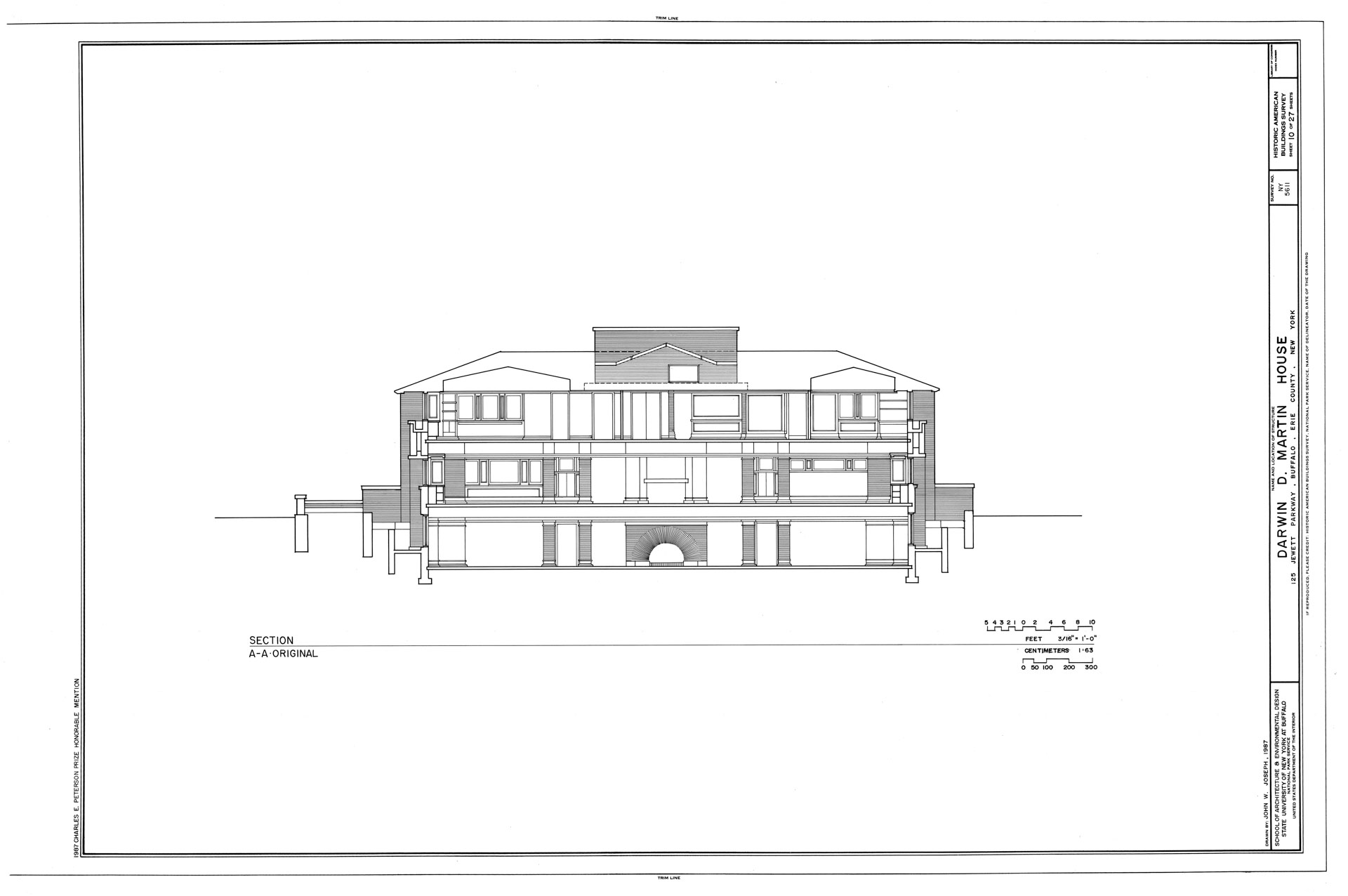Table Of Content

The library, dining, and living rooms were differentiated from each other by the cabinetry and clusters of piers as well as by raised and lowered ceilings with wood beams, to create an open spatial unit. Wright designed all the furniture and fittings, including the piano bench for the custom Steinway. The finishes, furnishings, fabrics, and fixtures were either restored or reproduced. In 2009, a new glass-and-steel orientation center, the Eleanor and Wilson Greatbatch Pavilion designed by Toshiko Mori Architect, was added. The conservatory is an indoor glass-enclosed garden for protecting, cultivating, and showcasing rare and tropical plants.
Unity Temple Exterior
In addition to existing wear and tear, the home sustained earthquake damage in 1994. Progress toward repairing it and insulating the structure against future rumbles has been somewhat fitful, and the home is currently closed to the public. Suzanne Stephens, a former deputy editor of Architectural Record, has been a writer, editor, and critic in the field of architecture for several decades. She has a Ph.D. in architectural history from Cornell University, and teaches a seminar in the history of architectural criticism in the architecture program of Barnard and Columbia colleges.
This forgotten Frank Lloyd Wright house is an architectural marvel at the end of a sleepy residential street.
The Larkin Building was modern for its time, with conveniences like air conditioning. Designed and built between 1904 and 1906, it was Wright's first large, commercial enterprise. With its open-form cruciform plan, broad low-pitched eaves, and ribbons of windows, the Barton House is a shining example of one of Wright’s earliest forays into the Prairie style of architecture.
Star-Loved Interior Designer Pamela Shamshiri Talks Her New Book, Favorite L.A. Stores and Dream City to Visit
The plan is based on Wright’s concept of organic architecture which is notable for artfully blurring the distinction between interior and exterior space. The grounds of the estate are punctuated with expansive gardens and outdoor rooms, which contain a variety of colorful floral plantings, trees, shrubs, and vines. The landscape’s most distinctive feature is an arc of seasonal blooms, known as the floricycle, that encompasses the east verandah of the main house. In addition to the spaces visited on the Martin House tour, the Plus Tour takes visitors inside the additional Wright-designed residences on the estate.
The 1,668 square foot cottage, like other structures on the property, contains a signature pattern of art glass as well as built-in planters to bring nature closer to the interior. The Martin house was part of a larger complex, which ultimately included the Barton house; a long pergola connecting the Martin house to a glass-ceilinged conservatory and garage; and a gardener’s cottage. The remarkable leaded glass windows of the Martin house were fabricated by the Linden Glass Co. of Chicago. The geometric, stylized plant-like forms of the windows contrast with the figurative wisteria designs found in the mosaic fireplace surround designed by Orlando Giannini, another of Wright’s frequent collaborators.
Explore the Barton House, the first Prairie house built on the site for Martin’s sister and her family, and the Gardener’s Cottage, where you will see Wright’s concept for affordable housing beautifully executed. Along the way, your docent will expand on the Martin/Wright story to provide a more detailed context for these architectural masterpieces. The vacant buildings stood forgotten and deteriorating for nearly two decades. In fact, the carriage house, conservatory, and pergola didn’t make it; they were demolished in the 1960s. Fortunately, the site was designated a National Historic Landmark in 1986 and restoration efforts began in 1992. The lost structures were rebuilt, and the Martin House was painstakingly restored to its original, nigh-perfect beauty.
Experimental structures built by apprentice architects dot the landscape. Wright and his apprentices gathered desert rocks and sand to build this 600 acre complex near Scottsdale, Arizona. Wright envisioned Taliesin West as a bold new concept for desert living—"a look over the rim of the world" as organic architecture—and it was warmer than his summer home in Wisconsin.

“I think in some respects, you could start to make the case that everyone here is now an interior designer.” Indeed, the city’s design scene has boomed, with new shops and showrooms sprouting up every month. What’s most exciting about this design renaissance, though, is the range of visions and styles represented around the city—due in part, perhaps, to the constant flow of new residents from around the country and world. Design scene is equally embracing of the primitive and the cutting-edge, the refined with the unrefined,” says Adam Blackman of Blackman Cruz, on Highland Avenue. Inside, Wright created niches and alcoves with freestanding brick piers, built-in oak cabinetry, art-glass windows, and lighting fixtures. Until he died in 1959, Frank Lloyd Wright stayed at Taliesin in Wisconsin every summer, and Taliesin West in Arizona in the winter.
Double Up On Buffalo's Iconic Architecture With This Martin House/Graycliff Experience - Step Out Buffalo
Double Up On Buffalo's Iconic Architecture With This Martin House/Graycliff Experience.
Posted: Mon, 10 Apr 2023 07:00:00 GMT [source]
Louvre Considers Moving Mona Lisa To Underground Chamber To End 'Public Disappointment'
No matter how you give, you are advancing our mission to preserve, interpret, promote, and sustain the Martin House for future generations. Next to it is a smaller house for Martin’s sister, Delta, and her husband, George Barton. As with most of the structure, its horizontality is articulated by Roman bricks with raked profiles and concrete cappings. Almost continuously occupied since its completion in 1903, Barton House is considered one of the best preserved of any of Wright’s Prairie style homes, thanks to excellent stewardship by its owners over the years.
In addition to the historic buildings on the estate, an award-winning, contemporary visitor center sits just west of the Martin House. The pergola is a long open air, covered walkway extending from the principal Martin residence to the conservatory. There are eleven openings on either side of the elevated structure, which serve as “windows” with framed views onto the surrounding gardens and outdoor rooms. Frank Lloyd Wright designed the plans for the Fontana Boathouse in 1905.
The smaller Prairie house design is near Darwin D. Martin's much larger house. The main rooms of the Thomas House are raised a full story above a high basement. The L-shaped floor plan of the house gives it an open view to the north and west, while obscuring a brick wall located on the south side. It was abandoned, partially demolished, and neglected in the period following the Martins’ life there. With the resolve of many, an ambitious restoration effort to save this treasure began in earnest in 1992 and was completed in 2019.
He designed Fallingwater, the Guggenheim Museum, and many other important buildings from the Wisconsin Taliesin studio. Today, Taliesin remains the summer headquarters of the Taliesin Fellowship, the school that Frank Lloyd Wright founded for apprentice architects. The multi-structure estate ( ) that Frank Lloyd Wright designed for Darwin D. Martin is a masterpiece of 20th century architecture.

No comments:
Post a Comment